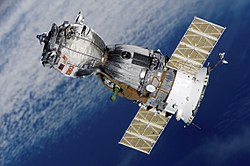This article needs additional citations for verification .(February 2013) |
| Operator | Rosaviakosmos |
|---|---|
| COSPAR ID | 1997-003A |
| SATCAT no. | 24717 |
| Mission duration | 184 days, 22 hours, 7 minutes, 40 seconds |
| Orbits completed | ~2,950 |
| Spacecraft properties | |
| Spacecraft type | Soyuz-TM |
| Manufacturer | RKK Energia |
| Launch mass | 7,150 kilograms (15,760 lb) |
| Crew | |
| Crew size | 3 up 2 down |
| Members | Vasili Tsibliyev Aleksandr Lazutkin |
| Launching | Reinhold Ewald |
| Callsign | Си́риус (Sirius) |
| Start of mission | |
| Launch date | February 10, 1997, 14:09:30 UTC |
| Rocket | Soyuz-U |
| End of mission | |
| Landing date | August 14, 1997, 12:17:10 UTC |
| Landing site | 170 kilometres (110 mi) SE of Dzhezkazgan |
| Orbital parameters | |
| Reference system | Geocentric |
| Regime | Low Earth |
| Perigee altitude | 378 kilometres (235 mi) |
| Apogee altitude | 394 kilometres (245 mi) |
| Inclination | 51.56 degrees |
| Docking with Mir | |
 Soyuz programme (Crewed missions) | |
Soyuz TM-25 was a crewed Soyuz spaceflight, which launched on February 10, 1997. [1] It transported Russian cosmonauts Vasily Tsibliyev, Aleksandr Lazutkin, and German cosmonaut Reinhold Ewald to Mir.

